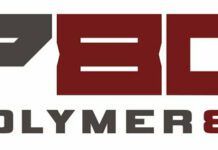We have occasionally dipped our toes in the very shallow pool that is single-shot or bolt-action handguns, beginning as far back as March 1998, in which we tested three single-shot 223 Remington-chambered handguns, the Thompson/Center Encore, Thompson/Center Contender, and Magnum Research Lone Eagle, with our pick being the Encore. Later that same year, we shot an Encore in 22-250 Remington along with bolt handguns from Remington, the XP-100R, and the Savage 510 Striker. The Striker won, with our team saying of it, “This gun looks rougher than the Remington, no question. However, we think its bolt placement gives it an advantage for the right-handed shooter, and the gun may be fired by a lefty just as easily.” In the June 2000 issue, we again looked at 22-250s, this time a Magnum Research Lone Eagle pitted against an Encore and a Savage 510F Striker, with the Savage being called a Best Buy. In September 2003, a Thompson Center Encore in 243 Winchester narrowly beat out a Savage Striker 516SAK for top honors, while an M.O.A. handgun failed to finish the test. So it’s been a minute since we tested this class of firearms, which made it all the more interesting to our Houston test team to examine two handguns chambered in 6.5 Creedmoor, a Christensen Arms Modern Precision Pistol, $2200; and a Savage 110 Pistol Chassis System 57797, $1000. Prices have definitely gone up from our last test, with the winning Encore 243 going for $558 in 2003 dollars.
How We Tested
First, we had to figure out how to test these two pistols. The platform requires optics, but what kind, with what purpose, and for what distance? So, we just tested a bit of everything. The Christensen arrived with a pistol-stabilizing brace mounted on a Picatinny rail at the rear of the receiver. The Savage has a section of Pic rail in the same location, for the same purpose, but does not include the brace. Finding and mounting such a brace is child’s play. An extended brace can be tucked into the shoulder and used as a make-shift stock. But according to the current administration, that is strictly against the rules and could land you in deep trouble. Don’t do it. We didn’t. The extended brace can also be properly wrapped around the forearm and used to stabilize the firearm. This is the legal way to use it, but doing so pushes the firearm further away from the face and necessitates the use of an appropriate optic.

We tested both the Swampfox Justice red dot, $239, and an extended eye-relief 2.75x20mm scope from Burris, $299, designed for scout rifles. Both were effective, though we preferred the red dot to the scope at closer ranges because it was much easier to use. The extended eye-relief reticle is very picky about eye relief, and we found ourselves having to work at it pretty hard to use the Burris. Once we lined it up correctly, however, even the slight amount of magnification was appreciated and useful. We would probably choose the Swampfox red dot for up close work — say 50 yards or so. Then we tried the just-released Crimson Trace 1-10×28 Hardline LPVO (Low Power Variable Optic), $650, and were amazed at what these two pistols could do when configured with LPVO. All groups were shot using the LPVO.
Their new Hardline scope comes with a 1x to 10x magnification range. The low power (1x) actually seems to be very close to a true 1 power. When it is dialed all the way down, our eyes saw very little difference or distortion as we moved from a view with the naked eye and one through the glass. We found the 10x to be more than sufficient for 600-yard shooting, though we yearned for adjustable parallax as we extended the range. Parallax is currently fixed at 100 yards. Still, images were as clear at distance as summertime Texas mirage would allow.
The second-focal-plane reticle means the crosshair size does not change with the magnification. The reticle is illuminated with a lighted inverted “T” at the intersection of the two stadia lines and additional dots at the 1, 2, 3, 4 and 5 Mil lines. The vertical stadia line is segmented between the Mil Dots, making them very easy to see and use. Of course, the second-focal-plane reticle only subtends the correct distances when magnification is cranked up to 10x. Windage and elevation turrets are capped with a zero mark that can be reset. Adjustments to windage and elevation seemed to be crisp and precise. The turrets are unarmored and are best left capped. This unit is designed to be aimed using hold off for distance and wind. That means that the sub tensions on the vertical stadia needed to be very accurate for the scope to work at longer ranges.
We were very pleased with the scope in action, not only doing well at 100 yards, but giving us precise enough holds to nail first-round hits at 417, 505, and 600 yards.
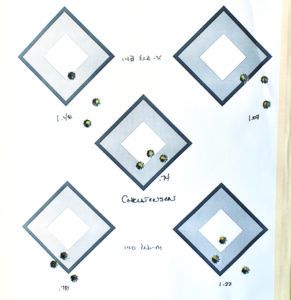
The average group sizes we report to you were collected while shooting these pistols as true pistols. We did not “wink, wink” forget and put the stock up to our shoulders accidentally, rendering both platforms more stable and, thus, even more accurate. We were impressed by what they allowed us to do as pistols. We believe that a real shoulder stock, mounted on either chassis, would be of considerable aid to the shooter. We also realize that would require registration with BATFE as a “Short Barreled Rifle” and a $200 tax stamp. There would also be the hassle of having to notify BATFE anytime the shooter wanted to cross state lines with the NFA weapon. Having said that, we think these two “pistols” were very good options as they arrived and could be superb firearms for backpacking or wilderness hunting.
All testing was done at American Shooting Centers in Houston. For accuracy testing, we fired multiple three-shot groups at 100 yards. All rifles were well-sandbagged in a Caldwell TackDriver Pro test further supported by a heavy rear bag from Tab Gear. We measured velocities with a LabRadar. We sourced our ammo at AmmoGuy.net, securing Norma Match 143 grain rounds along with Hornady 140-grain ELD-M and Hornady 143-grain ELD-X cartridges. Here’s what we found:
Gun Tests Grade: A (OUR PICK)
$2200
Christensen Arms is not exactly a stranger to the pages of Gun Tests. We’ve reviewed the company’s Ridgeline in 6.5 PRC (October 2020) and the Modern Precision Rifle chambered in 6 Creedmoor in March of 2021. Both rifles passed with flying colors, so we expected nothing less from the Modern Precision Pistol, aka MPP, which is a shortened version of the Precision Rifle.
| Action Type | Bolt |
| Overall Length, Stock Folded | 24.0 in. |
| Overall Length, Stock Extended | 33.4 in. |
| Overall Height | 7.0 in. |
| Maximum Width @ Bolt | 3.4 in. |
| Maximum Width, Chassis | 1.6 in. |
| Weight Unloaded w/o Stock | 5.2 lbs. |
| Weight Unloaded | 5.9 lbs. |
| Weight Loaded | 6.4 lbs. |
| Action Material | 416R stainless steel |
| Chassis Material | Aluminum alloy |
| Finish | Black nitride |
| Front Strap Height | 2.6 in. |
| Back Strap Height | 3.7 in. |
| Barrel Length | 12.5 in. |
| Receiver Scope-Base Pattern | Picatinny rail |
| Grip Thickness (Maximum) | 1.03 in. |
| Grip Circumference | 4.6 in. |
| Magazine | One 5-round, AICS compatible |
| Trigger Pull Weight | 1.3 lbs. |
| Trigger Span | 2.9 in. |
| Safety | Two position rocker switch |
| Warranty | Limited warranty; accuracy guarantee |
| Telephone | (435) 528-7999 |
| Website | ChristensenArms.com |
| Made In | U.S.A. |
Many desirable features are shared by both platforms. The action has been sculpted where possible to save weight, as have the bolt handle, bolt knob, and bolt shroud. Even the bolt body is fluted. The slim-sided action is made on the Christensen Arms pattern from a billet of 7075 aluminum alloy then hard-coat anodized. The MPP uses AICS-compatible magazines, and Christensen cuts out the left side of the magazine well to make it easier to reload while prone. There is an easily reached tactical magazine latch right in front of the trigger guard. Any standard AR grip should be compatible. It comes with a slim-line grip that we thought was perfect, considering the concept of the firearm. A sturdy bolt release is located at the left rear of the receiver. The action is topped with a 0-MOA Picatinny rail that abuts the inside of the ejection port, leaving it very resistant to movement under recoil. If the Pic rail isn’t your bag, the action is compatible with Remington 700 scope bases.
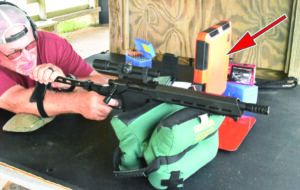
Christensen made its reputation working with carbon fiber on parts used in space exploration. Finding that firearms can benefit from some of the same technologies, Christensen applied its expertise to barrels and more. The barrel on the MPP is made from aero-grade stainless steel. Our sample was chambered in 6.5 Creedmoor and sported a 12.5-inch tube wrapped with carbon fiber. Twist was 1 turn in 8 inches — standard for the long bullets of the 6.5 CM. We noticed that their MPPs chambered in 300 AAC and 308 Winchester had twist rates that were not so standard. The 300 AAC was set at 1:7.5 and the 308 in 1:7 — perfect spin rates for those that want to suppress these short pieces for the hunting arena. There is also a pistol chambered in 223 Remington with a more normal 1:7 twist for heavy 223 Rem. bullets. The barrel is tipped with a 12-port muzzle brake that works very well and is very loud. This firearm begs for a suppressor and is threaded 5⁄8×24 to make that easy.
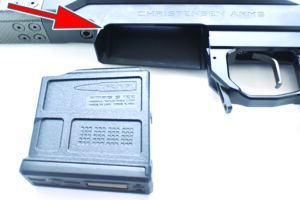
The fore end is also carbon fiber and free floats the barrel. It is sturdily attached to the action with eight screws and has M-Lok slots on the 3, 6, and 9 o’clock flats, along with two QD sockets. Ours came with a section of Pic rail on the bottom flat that worked great for an Atlas bipod. It also has a stop to keep the hand from moving too far forward. Topping it all off is a flat-faced Trigger Tech trigger that we were able to adjust down to 1.3 pounds with a simple Allen wrench. Standard deviation across 10 attempts was a mere 1.7 ounces. That could easily be too light, especially for those hunting with gloved hands, but we wanted to see what it could do at the range. The trigger can always be adjusted heavier if desired. The MPP complies with all NFA restrictions as a pistol and does not require a license as a short-barreled rifle. The chassis ends with an appropriate section of Picatinny rail. Attached to that rail is an extension mounted to a brace that allows those with less-than-normal hand function to more easily use the pistol. That brace can be folded against the left side of the receiver or removed completely.
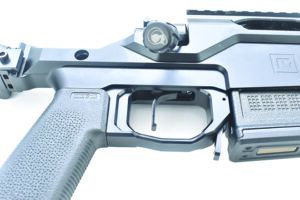
After considerable testing using all three optics types, we settled on testing both pistols with the 1-10×28 Crimson Trace and without using the pistol brace. This is a normal eye relief scope, and putting our faces that close to the ocular lens then firing the first few shots required dedication to the job. After we figured out that we weren’t bleeding anywhere, the testing proceeded apace. The Christensen MPP has a very effective muzzle brake. Movement was minimal, while muzzle blast was substantial. The recoil impulse was actually blasting a tight-fitting battery-compartment cover off the back of our LabRadar every few shots. We soon learned to hold it more like a pistol, employing a well-locked wrist, and then stroking the trigger like on a good rifle. Accuracy results were impressive, yielding three-shot groups that averaged 0.97 inches across three different kinds of ammunition. The Norma Match produced best results with a mere 0.73-inch average. Velocities achieved though the 12.5-inch barrel of the Christensen was 250 to 300 fps lower than those clocked from a 24-inch barrel — as expected. Even with the lower velocities, deer-worthy energy (at least 1000 foot-pounds at impact) was achieved to right at 450 yards. Not bad from a pistol. Function, of course, was flawless, and the Trigger Tech trigger was marvelous.
Our Team Said: This pistol is expensive, but we would expect that from the carbon-fiber materials used in its construction. The Christensen Arms MPP is light weight, accurate, and easy to operate, once you’ve acclimated to the odd mechanics of firing.
| Norma 143-grain Match | Christensen MPP | Savage 110 PCS |
| Average Velocity | 2348 fps | 2141 fps |
| Muzzle Energy | 1738 ft.-lbs. | 1457 ft.-lbs. |
| Average Group | 0.73 in. | 1.37 in. |
| Best Group | 0.57 in. | 1.16 in. |
| Hornady 140-grain ELD-M | Christensen MPP | Savage 110 PCS |
| Average Velocity | 2386 fps | 2189 fps |
| Muzzle Energy | 1770 ft.-lbs. | 1490 ft.-lbs. |
| Average Group | 0.91 in. | 2.09 in. |
| Best Group | 0.74 in. | 1.67 in. |
| Hornady 143-grain ELD-X | Christensen MPP | Savage 110 PCS |
| Average Velocity | 2349 fps | 2172 fps |
| Muzzle Energy | 1753 ft.-lbs. | 1498 ft.-lbs. |
| Average Group | 1.28 in. | 1.14 in. |
| Best Group | 1.07 in. | 0.74 in. |



























